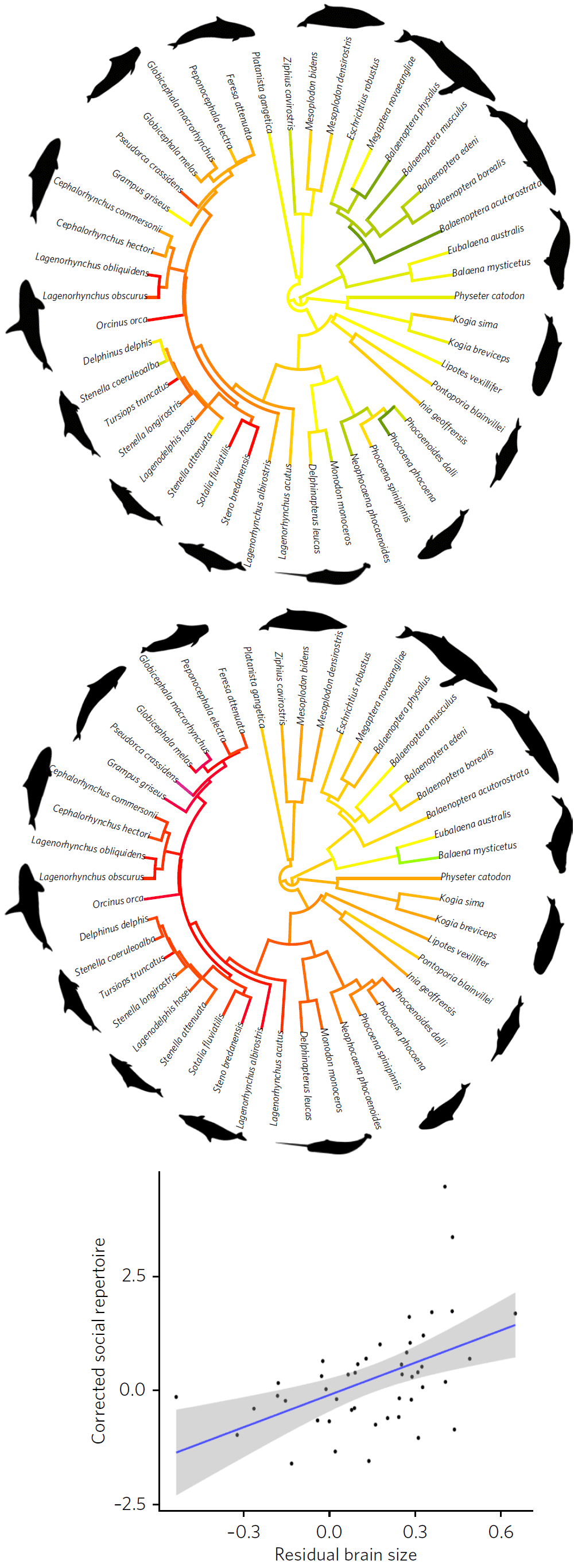The advanced intelligence of whales and dolphins - an evolutionary reaction to the need to live in society
 Scientists have long noticed that advanced intelligence and an evolutionary brain are present in humans and other animals, often demonstrating social behavior. This prompted the anthropologist and evolutionary psychologist Robin Dunbar to propose the social brain hypothesis . According to the theory, a person has developed a large brain in order to be able to live in large social groups. Although in the past 20,000 years, due to the “domestication” of man, his brain has decreased in size, but before that, evolution had to quickly increase the brain of hominids in a relatively short period, so that people could unite into large tribes.
Scientists have long noticed that advanced intelligence and an evolutionary brain are present in humans and other animals, often demonstrating social behavior. This prompted the anthropologist and evolutionary psychologist Robin Dunbar to propose the social brain hypothesis . According to the theory, a person has developed a large brain in order to be able to live in large social groups. Although in the past 20,000 years, due to the “domestication” of man, his brain has decreased in size, but before that, evolution had to quickly increase the brain of hominids in a relatively short period, so that people could unite into large tribes.
In social communication, it is very important to recognize the so-called "outside knowledge", that is, to understand the hierarchy, social interrelations and relationships like "she knows what he knows" and the like. For example, the alpha male of a chimpanzee chooses any females for himself, but he is tolerant of attempts to mate with them from those who helped him reign on the throne. Without a sufficiently advanced brain, such subtleties of the social hierarchy cannot be learned.
Now a group of scientists from the USA and the UK has published a new scientific paper “The social and cultural roots of the brain of whales and dolphins, ” which confirms the hypothesis of a social brain.
Representatives of the cetacean group (dolphins and whales) have the most advanced nervous system among all taxonomic groups, and they are highly rated for any characteristic of neuroanatomical complexity. At the same time, many cetaceans are also organized into hierarchical social structures and demonstrate an amazing breadth of cultural and social behavior, the features of which, which are rare for animals, are very similar to the social behavior of humans and primates. But so far very little evidence has been gathered of the correlation between the large brain, social structures and the cultural behavior of cetaceans.
Whales and dolphins have discovered a huge number of signs of complex social behavior, including:
- relationship in complex alliances;
- social transfer of hunting techniques (training);
- joint hunting;
- complex singing, including singing in regional group dialects;
- speech mimicry (imitation of other people's voices);
- the use of "voice signatures-identifiers", unique to a particular individual;
- interspecific cooperation with humans and other animals;
- alloparental care for someone else's cub (for example, from the side of a female helper or “nurse”);
- social games.
All these patterns of social behavior are studied and described in detail in the scientific press, but a comparative study of types of cetaceans has not yet been carried out in terms of complex social behavior, degree of innovation and learning of new behavior so that the degree of advancement of social skills can be compared to the size of the brain. Such studies have previously been conducted in birds and primates, but not in cetaceans. Now this gap in scientific knowledge is eliminated.
The researchers collected a large array of data for each species of cetaceans: body weight, brain size, the degree of social intercourse on the above characteristics - and calculated the correlation between these indicators. The first diagram below shows the relationship between species and the size of the brain (red corresponds to a larger size, green to a smaller one). The second diagram shows social behavior indicators (social repertoire). In the end, below is a graph of the relationship between these two parameters.

Scientists have found that the evolutionary development of the brain is associated with the social structure of the species and with the size of the group. Moreover, the connection with the size of the group is quadratic, that is, the most developed brain and advanced social behavior demonstrate groups of medium size, and not small or large groups.
The authors of the research point to explicit parallels between marine mammals and primates / humans. In dolphins and whales, there is also a combination of simultaneously large brain, hypersocial behavior and a variety of behavioral patterns. It is these qualities that allowed man to multiply in incredible quantities and populate the entire Earth. Scientists believe that dolphins and human intellectuals are able to manifest themselves in the course of evolution as a kind of evolutionary reaction to the need to live in a society of their own kind.
The scientific article was published on October 16, 2017 in the journal Nature Ecology & Evolution (doi: 10.1038 / s41559-017-0336-y, pdf ).
All Articles